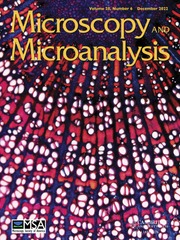Crossref Citations
This article has been cited by the following publications. This list is generated based on data provided by
Crossref.
Zhou, Yiming
and
Zhao, Li‐Dong
2017.
Promising Thermoelectric Bulk Materials with 2D Structures.
Advanced Materials,
Vol. 29,
Issue. 45,
Peng, Kunling
Wu, Hong
Yan, YanCi
Guo, Lijie
Wang, Guoyu
Lu, Xu
and
Zhou, Xiaoyuan
2017.
Grain size optimization for high-performance polycrystalline SnSe thermoelectrics.
Journal of Materials Chemistry A,
Vol. 5,
Issue. 27,
p.
14053.
Tang, Yu
Li, Decong
Chen, Zhong
Deng, Shuping
Sun, Luqi
Liu, Wenting
Shen, Lanxian
and
Deng, Shukang
2018.
Excellent thermal stability and thermoelectric properties of
Pnma
-phase SnSe in middle temperature aerobic environment
.
Chinese Physics B,
Vol. 27,
Issue. 11,
p.
118105.
Wei, Wei
Chang, Cheng
Yang, Teng
Liu, Jizi
Tang, Huaichao
Zhang, Jian
Li, Yusheng
Xu, Feng
Zhang, Zhidong
Li, Jing-Feng
and
Tang, Guodong
2018.
Achieving High Thermoelectric Figure of Merit in Polycrystalline SnSe via Introducing Sn Vacancies.
Journal of the American Chemical Society,
Vol. 140,
Issue. 1,
p.
499.
Liu, Chengyan
Miao, Lei
Wang, Xiaoyang
Wu, Shaohai
Zheng, Yanyan
Deng, Ziyang
Chen, Yulian
Wang, Guiwen
and
Zhou, Xiaoyuan
2018.
Enhanced thermoelectric properties of p-type polycrystalline SnSe by regulating the anisotropic crystal growth and Sn vacancy.
Chinese Physics B,
Vol. 27,
Issue. 4,
p.
047211.
Li, Shan
Li, Xiaofang
Ren, Zhifeng
and
Zhang, Qian
2018.
Recent progress towards high performance of tin chalcogenide thermoelectric materials.
Journal of Materials Chemistry A,
Vol. 6,
Issue. 6,
p.
2432.
Chang, Cheng
Tan, Gangjian
He, Jiaqing
Kanatzidis, Mercouri G.
and
Zhao, Li-Dong
2018.
The Thermoelectric Properties of SnSe Continue to Surprise: Extraordinary Electron and Phonon Transport.
Chemistry of Materials,
Vol. 30,
Issue. 21,
p.
7355.
Chen, Zhi-Gang
Shi, Xiaolei
Zhao, Li-Dong
and
Zou, Jin
2018.
High-performance SnSe thermoelectric materials: Progress and future challenge.
Progress in Materials Science,
Vol. 97,
Issue. ,
p.
283.
Zhang, Bin
Li, Ang
Han, Guang
Zhang, Zhenhua
Peng, Kunling
Gong, Xiangnan
Zhou, Xiaoyuan
and
Han, Xiaodong
2020.
Dynamic Epitaxial Crystallization of SnSe2 on the Oxidized SnSe Surface and Its Atomistic Mechanisms.
ACS Applied Materials & Interfaces,
Vol. 12,
Issue. 24,
Chang, Yih-Ren
Nishimura, Tomonori
and
Nagashio, Kosuke
2021.
Thermodynamic Perspective on the Oxidation of Layered Materials and Surface Oxide Amelioration in 2D Devices.
ACS Applied Materials & Interfaces,
Vol. 13,
Issue. 36,
p.
43282.
Luo, Xian
Huang, Bowei
Guo, Xiang
Lu, Wenjie
Zheng, Guiyuan
Huang, Bin
Li, Jiankang
Li, Pengtao
and
Yang, Yanqing
2021.
High ZT Value of Pure SnSe Polycrystalline Materials Prepared by High-Energy Ball Milling plus Hot Pressing Sintering.
ACS Applied Materials & Interfaces,
Vol. 13,
Issue. 36,
p.
43011.
Li, Feng
Wang, Huide
Huang, Ruijia
Chen, Wenwen
and
Zhang, Han
2022.
Recent Advances in SnSe Nanostructures beyond Thermoelectricity.
Advanced Functional Materials,
Vol. 32,
Issue. 26,
Liu, Jie
Li, Jingwei
Gu, Lixin
Wu, Hong
Han, Guang
Wang, Dengkui
Zhou, Jinfei
Gong, Xiangnan
Yang, Dingfeng
Zheng, Sikang
Zhang, Daliang
Zhang, Bin
and
Zhou, Xiaoyuan
2022.
Self-assembled epitaxy of Ga2Se3 on the oxidized GaSe surface and atomic imaging of the Ga2Se3/GaSe heterostructure.
Applied Surface Science,
Vol. 586,
Issue. ,
p.
152774.
Chang, Yih-Ren
Nishimura, Tomonori
Taniguchi, Takashi
Watanabe, Kenji
and
Nagashio, Kosuke
2022.
Performance Enhancement of SnS/h-BN Heterostructure p-Type FET via the Thermodynamically Predicted Surface Oxide Conversion Method.
ACS Applied Materials & Interfaces,
Vol. 14,
Issue. 17,
p.
19928.
Xin, Nan
Li, Yifei
Tang, Guihua
and
Shen, Longyun
2022.
Enhancing thermoelectric performance of K-doped polycrystalline SnSe through band engineering tuning and hydrogen reduction.
Journal of Alloys and Compounds,
Vol. 899,
Issue. ,
p.
163358.
Zheng, Yue
You, Qi
Yin, Zhentian
Tang, Jian
Jiang, Ke
Xie, Zihao
Li, Henan
Han, Cheng
and
Shi, Yumeng
2024.
Optimizing 2D-metal contact in layered Tin-selenide via native oxide modulation.
Nano Research,
Vol. 17,
Issue. 4,
p.
3014.


